
www.rhci-online.net/radiogram/radiogram.htm
██╗ ██╗██████╗ ██████╗ ██████╗ █████╗ ██████╗ ██╗ ██████╗ ██████╗ ██████╗ █████╗ ███╗ ███╗ ██║ ██╔╝██╔══██╗██╔════╝ ██╔══██╗██╔══██╗██╔══██╗██║██╔═══██╗██╔════╝ ██╔══██╗██╔══██╗████╗ ████║ █████╔╝ ██████╔╝██║ ██████╔╝███████║██║ ██║██║██║ ██║██║ ███╗██████╔╝███████║██╔████╔██║ ██╔═██╗ ██╔══██╗██║ ██╔══██╗██╔══██║██║ ██║██║██║ ██║██║ ██║██╔══██╗██╔══██║██║╚██╔╝██║ ██║ ██╗██████╔╝╚██████╗ ██║ ██║██║ ██║██████╔╝██║╚██████╔╝╚██████╔╝██║ ██║██║ ██║██║ ╚═╝ ██║ ╚═╝ ╚═╝╚═════╝ ╚═════╝ ╚═╝ ╚═╝╚═╝ ╚═╝╚═════╝ ╚═╝ ╚═════╝ ╚═════╝ ╚═╝ ╚═╝╚═╝ ╚═╝╚═╝ ╚═╝
|
RSID:
<<2014-12-27T12:30Z
MFSK-64 @
6095000+1500>>
<STX>
Thank you to The Mighty KBC
for keeping shortwave alive
in 2-0-1-5
Best wishes for the new year ...
<EOT>
<STX>
Sending Pic:159x92C;

<EOT>
██╗ ██╗ ██████╗ █████╗ ██████╗ █████╗ ██████╗ ██╗ ██████╗ ██████╗ ██████╗ █████╗ ███╗ ███╗ ██║ ██║██╔═══██╗██╔══██╗ ██╔══██╗██╔══██╗██╔══██╗██║██╔═══██╗██╔════╝ ██╔══██╗██╔══██╗████╗ ████║ ██║ ██║██║ ██║███████║ ██████╔╝███████║██║ ██║██║██║ ██║██║ ███╗██████╔╝███████║██╔████╔██║ ╚██╗ ██╔╝██║ ██║██╔══██║ ██╔══██╗██╔══██║██║ ██║██║██║ ██║██║ ██║██╔══██╗██╔══██║██║╚██╔╝██║ ╚████╔╝ ╚██████╔╝██║ ██║ ██║ ██║██║ ██║██████╔╝██║╚██████╔╝╚██████╔╝██║ ██║██║ ██║██║ ╚═╝ ██║ ╚═══╝ ╚═════╝ ╚═╝ ╚═╝ ╚═╝ ╚═╝╚═╝ ╚═╝╚═════╝ ╚═╝ ╚═════╝ ╚═════╝ ╚═╝ ╚═╝╚═╝ ╚═╝╚═╝ ╚═╝
RSID: <<2014-12-27T16:01Z
MFSK-32 @ 17860000+1500>>
<STX>
Welcome to program 91 of VOA Radiogram from the Voice of America.
I'm Kim Andrew Elliott in Washington.
Here is the lineup for today's program (all in MFSK32 except
where noted):
1:38 Program preview (now)
2:38 Mobile computer lab in Nairobi*
8:04 US wants open Internet in Cuba*
21:50 Launch of Russia's new Angara rocket*
26:18 Closing announcements*
28.22 Bonus mode: MFSK16
*with image
Please send reception reports to radiogram@voanews.com.
And visit voaradiogram.net.
Twitter: @VOARadiogram
<EOT>
<STX>
VOA NEWS
Nairobi's Mobile, Solar-Powered Computer Lab Helps Thousands
Lenny Ruvaga
December 23, 2014
NAIROBI - In Kawangware, one of Nairobi's poorest and
fastest-growing slums, 20-year-old Allan Mideva intently goes
through the digital paces. Just one of some 20 students being
taught basic computer skills, he has attended the free daily
lessons without fail for nearly three months.
It's an opportunity he normally could not afford. His mother
earns about $2 a day washing clothes, and similar training
usually costs as much as $100 at traditional learning
institutions. But Mideva said he only had to pay a one-time fee
of $2.20 to show he was serious about studying.
"The tutor is very friendly; he enables us to understand more,
[and] it's cost effective, only 200 shillings compared to the
other colleges," he said. "This project enables us to have
computer skills."
Craft Silicon Foundation — a Narobi-based non-profit group —
began offering the free information and communication technology
courses to under-privileged young people five years ago.
The training takes 10 weeks. If students pass the final exam,
they receive certificates of graduation. But this is no
traditional class setting. It is in a bus with 12 computers
powered by solar panels.
In a community where the majority of residents try to survive on
less than $1 a day with little hope of improving their futures,
this $100,000 mobile computer lab has helped close to 7,000
students.
With offices in Kenya, Tanzania, India and the United States, the
financial software company that supports the program also
promotes computer literacy as part of its corporate philosophy of
social responsibility.
"Education is still a luxury at some of these slums, so we
believe that as much as it's so important we must go to slum
areas where they cannot afford to get technological education,"
says CEO Kamal Budhabhatti.
The Kenyan government also plans to increase Internet literacy
and access to information by providing free Internet in 2015 to
all the informal settlements in Nairobi.
For now, these students from Kawangware look forward to
completing their course and working toward a better tomorrow.
http://www.voanews.com/content/nairobi-kenya-mobile-computer-training-lab/2570956.html
<EOT>
<STX>
Image: Screen capture from the video version of this VOA News
story ...
<EOT>
<STX>
Sending Pic:227x128C;

<EOT>
RSID: <<2014-12-27T16:07Z
MFSK-32 @ 17860000+1500>>
<STX>
This is VOA Radiogram from the Voice of America.
Please send reception reports to radiogram@voanews.com.
VOA NEWS
US Wants Open Internet Highway in Cuba
Doug Bernard
December 23, 2014
WASHINGTON - When Cubans learned of their government's new
relationship with the United States last week, it's likely almost
none of them read about it online.
Access to the Web is severely limited, extremely slow and priced
beyond what most Cubans can afford. And that's even before
considering the massive censorship of content and persecution of
bloggers critical of the regime.
Perhaps it's no surprise that high on the Obama administration's
new priority list for Cuban-U.S. relations is to see the island
nation more fully connected to the World Wide Web, as well as
pushing for increased freedom of access and speech.
But if the Internet is going to be one of the principal tools for
changing Cuba, the very first task is now connecting a nation
largely left behind in the digital revolution.
11 million citizens
Despite the U.S. embargo, Cuban officials like to tout that all
11 million Cuban citizens have free and unrestricted access to
education, housing and medicine.
But for years that same access has been all but absent for the
Internet and other digital forms of communication like mobile
phones.
The United Nation's International Telecommunications Union
estimates that only about 25 percent of Cubans have access to the
Internet - up from nearly zero in 2000. But that number only
represents the percent that potentially has access; many
estimates say the real percentage is much lower.
Researchers at Freedom House, an independent NGO focused on
issues of expanding freedoms, estimate that actual Internet
penetration for 2011 was only 5 percent, making the nation one of
the least connected in the world.
Access to devices is also a problem.
In 2008, Havana began to allow the purchase of some mobile phones
and computers for private use. However, five years later the ITU
estimates that only 17 percent of Cubans have access to mobile
phones, with nearly all of them only second-generation devices
that don't support Web access. The percentage of households with
a computer is far lower.
There are a few cyber cafes in Cuba, but cost becomes another
access problem.
The group Reporters Without Borders, which has declared Cuba an
"enemy of the Internet," estimates that it costs on average the
equivalent of $5 to $7 for a half-hour connection to the
Internet. But that the average monthly salary in Cuba equals only
$20, making frequent access prohibitive.
Getting online is only half the problem for Cubans. The other,
and more problematic issue, is the rigid control the government
exerts over what people can see and say while online.
Particularly in the government's crosshairs are Cuban bloggers
who openly criticize the regime.
In 2012, following a brief period where the government appeared
to ease restrictions, Havana again cracked down, shuttering a
range of blogs and websites, restricting access to email content
at work, and jailing a number of cyber activists and critics.
Among the prominent Cuban bloggers that have tangled with the
government is Yoani María Sánchez, lead author of the "Generación
Y" blog.
While never jailed, Sanchez remains a thorn in the side of the
Castros and her blog is blocked within Cuba. (She publishes it by
sending blog entries to friends outside Cuba, who then post it on
non-Cuban servers.)
As for content coming from outside of Cuba, the government
routinely employs an unsophisticated series of blocks on
thousands of websites. While these blocks are fairly easy to
bypass, the government may have decided that the lack of access
to the Web makes these sites relatively harmless.
Mystery cable
While much of Latin America has been busily building greater
connections to the world via the Internet, Cuba is almost
completely cut off.
Much of the globe's data traffic flows through undersea
fiber-optic cables, transmitting enormous amounts of information
and linking countries and continents together in what we know as
the Web.
A map of submarine fiber optic cables showing Cuba's
near-isolationA map of submarine fiber optic cables
showing
Cuba's near-isolation
But a look at the map of global submarine cables provided by
Global Bandwidth Research Service clearly shows that while most
of the Caribbean and Latin America is connected through dozens of
cables, all but one completely bypass Cuba.
And that cable, the ALBA-1, may have in fact lain dormant until a
U.S.-based researcher discovered its existence.
In 2011, the ALBA-1 cable was quietly strung between La Guaira,
Venezuela and Siboney, Cuba. (It has since been extended from
Cuba to Jamaica.)
Owned by Telecom Venezuela, for several years it remained
mysteriously quiet until 2013, when Doug Madory, a research
analyst with Dyn Research, noticed it was suddenly turned on.
While the ALBA-1 greatly increased the amount of data that could
flow to Cuba, Madory cautions that the Castro regime still is in
control of just how much will.
"Yesterday's historic agreement to begin normalizing relations
between Cuba and the United States contains a pledge by the Cuban
government to ‘greatly expand its citizens' access to the
Internet,' " Madory wrote last week on his blog. "What exactly
this pledge entails will determine how the Internet evolves in
Cuba in the near term.
"Decision makers in Cuba should look at another country that
recently opened up its telecom sector and is presently
experiencing an explosion in Internet growth: Myanmar," he wrote.
'Lighting up the island'
While it's unknown yet how the new U.S.-Cuba relationship will
affect access to an uncensored Internet for the island's 11
million residents, it's clear that Washington is making this a
top priority.
"I believe in the free flow of information," President Barack
Obama said when he unveiled his new Cuba policy. "Unfortunately,
our sanctions on Cuba have denied Cubans access to technology
that has empowered individuals around the globe."
That's leading many to believe the Obama administration will push
as hard as it can for Cuban officials to open up the island to
telecommunications companies looking to build out increased
Internet fiber and mobile data access.
"The government here did its best to restrict the flow of
information," Jeffrey DeLaurentis, the U.S.'s highest-ranking
official in Cuba, told the CBS TV program "60 Minutes" this
Sunday. "And they have committed to providing more access to the
Internet to the Cuban people.
"We believe that lighting up the island is going to make a major
change here," DeLaurentis said.
While it's likely the Cuban government will seek to expand its
digital and mobile capacity, that may not mean that Cubans will
readily adopt U.S.-style websites and social media.
Sujatha Fernandes and Alexandra Halkin with the National American
Congress on Latin America, or NACLA, write that some Cubans have
already begun building their own alternative network for sharing
information and commentary.
Called "El Paquete Seminal," or the Weekly Packet, it's a 1
terabyte eclectic compilation of all sorts of media: current
movies, YouTube clips, technology reports, Cuban and
international news and much more. This packet is then circulated
hand-to-hand across the island - sort of a samizdat for the
digital age.
However it develops, blogger Sánchez is optimistic the changing
U.S.-Cuba policy will lead to greater freedom for those who want
to read or write the kind of material found in "Generación Y."
"Today was a political defeat," she writes of the Cuban
government's new stance to the United States. "David can't live
without Goliath and the ideological apparatus has depended too
long on this dispute."
http://www.voanews.com/content/us-wants-open-internet-highway-in-cuba/2569258.html
<EOT>
<STX>
Image: A map of submarine fiber optic cables showing Cuba's
near-isolation ...
<EOT>
| <STX> Sending Pic:231x124C; |
Internet: |
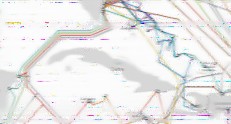 <EOT>
|
|
RSID: <<2014-12-27T16:21Z
MFSK-32 @ 17860000+1500>>
<STX>
This is VOA Radiogram from the Voice of America.
Please send reception reports to radiogram@voanews.com.
From Radio Free Europe/Radio Liberty:
Russia Says Test Of New Angara Rocket A Success
December 23, 2014
Russia says it has successfully conducted the first test launch
of a powerful new booster rocket it has been developing for
years.
Reporting to President Vladimir Putin, Defense Minister Sergei
Shoigu said the Angara-A5 rocket lifted off at 8:57 a.m. local
time (0557 GMT/UTC) from the Plesetsk launch facility in
northwestern Russia.
Putin, who took part in the launch ceremony by videolink, offered
his congratulations on a "successful launch" and said the new
rocket would "seriously strengthen Russia's security."
He said the Angara would put satellites in orbit "for systems of
early warning of missile attacks, intelligence, navigation,
communications, and relay."
State-run news agency TASS said Russia has spent 22 years and
some $3 billion developing the 55-meter, 773-ton Angara, its
biggest new rocket since the Soviet era.
Its powerful engine is designed to put Russia's heaviest
satellites into orbit.
The Kremlin hopes it will reduce and help eventually end Russia's
reliance on the Baikonur launch facility, which Moscow leases
from Kazakhstan.
Based on reporting by Interfax, TASS, and spaceflightnow.com
http://www.rferl.org/content/russia-space-rocket/26758120.html
<EOT>
<STX>
Image: Launch of the Angara-A5 rocket ...
<EOT>
<STX>
Sending Pic:149x242C;
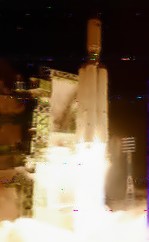
<EOT>
RSID: <<2014-12-27T16:25Z
MFSK-32 @ 17860000+1500>>
<STX>
Please send reception reports to radiogram@voanews.com.
And visit voaradiogram.net.
Twitter: @VOARadiogram
Thanks to colleagues at the Edward R. Murrow shortwave
transmitting station in North Carolina.
I'm Kim Elliott. Please join us for the next VOA Radiogram.
This is VOA, the Voice of America.
<EOT>
<STX>
Sending Pic:192x129C;

<EOT>
RSID: <<2014-12-27T16:27Z
MFSK-16
@ 17860000+1500>>
<STX>
Thank you for decoding the modes on VOA Radiogram during 2014,
and best wishes for 2015 ...
<EOT>
www.rhci-online.net/radiogram/radiogram.htm
|
QTH: |
D-06193 Petersberg (Germany/Germania) |
|
|
Ant.: |
Dipol for 40m-Band & Boomerang Antenna 11m-Band |
|
|
RX for RF: |
FRG-100B + IF-mixer & ICOM IC-R75 + IF-mixer |
|
|
Software IF: |
con STUDIO1 - Software italiano per SDR [S-AM-USB/LSB] |
|
|
Software AF: |
||
|
OS: |
German XP-SP3 with support for asian languages |
German W7 32bit + 64bit |
|
PC: |
MEDION Titanium 8008 (since 2003) [ P4 - 2,6 GHz] |
MSI-CR70-2MP345W7 (since2014) [i5 -P3560 ( 2 x 2,6GHz) ] |
DRM-images - received via EASYPAL/DSSTV on 14233kHz/USB (FRG-100 / Dipol for ~12 MHz)
Only the screenshot on the top in my
collage is from me - the rest comes from other radio
amateurs.
Radio amateurs can send digital images with EasyPal
on shortwave. In most cases, the computer on which running EasyPal,
is connected to the Internet.
This makes it possible to make remote
access over the Internet to the achieved SNR values.
So you can get information from people who only listen - more specifically
- watch. (but can not send ==> "SWL").
I use "R0GER" as SWL-fantasy-call. So you can distinguish
my values of other N0CALLS ....
By providing my locator the "R0GER-call" appeared in the link-maps of some radio
amateurs.
(but sometimes not at the correct site ...
;-)
roger
<P.S.>
The first EasyPal
image which I was able to decode, was sent in a program of VoA. Without
this information I had never met the colorful side of the shortwave.
A picture is worth a 1000 words, especially when the people speak so many
languages ..... Thank you so much!
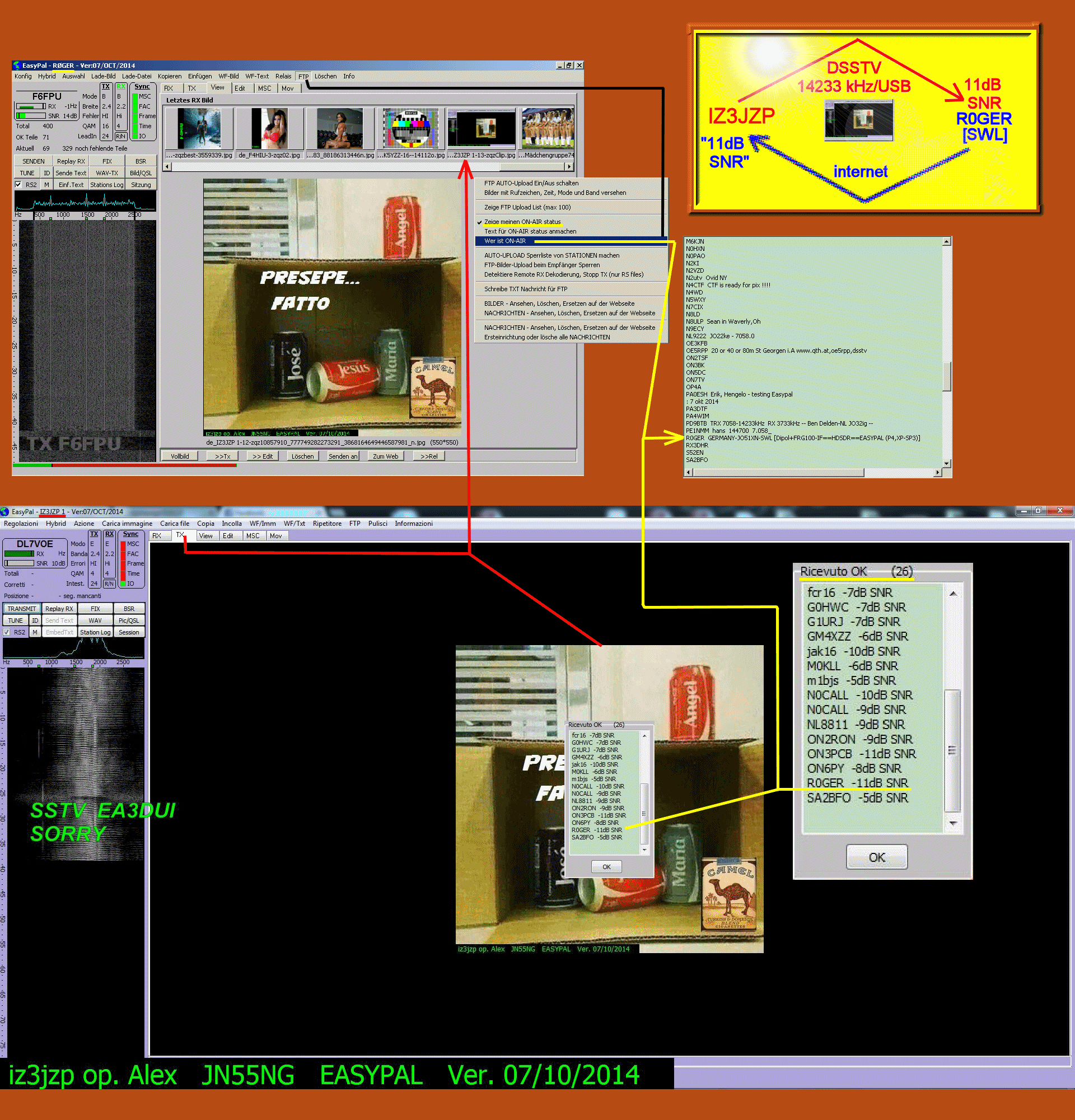 |
|
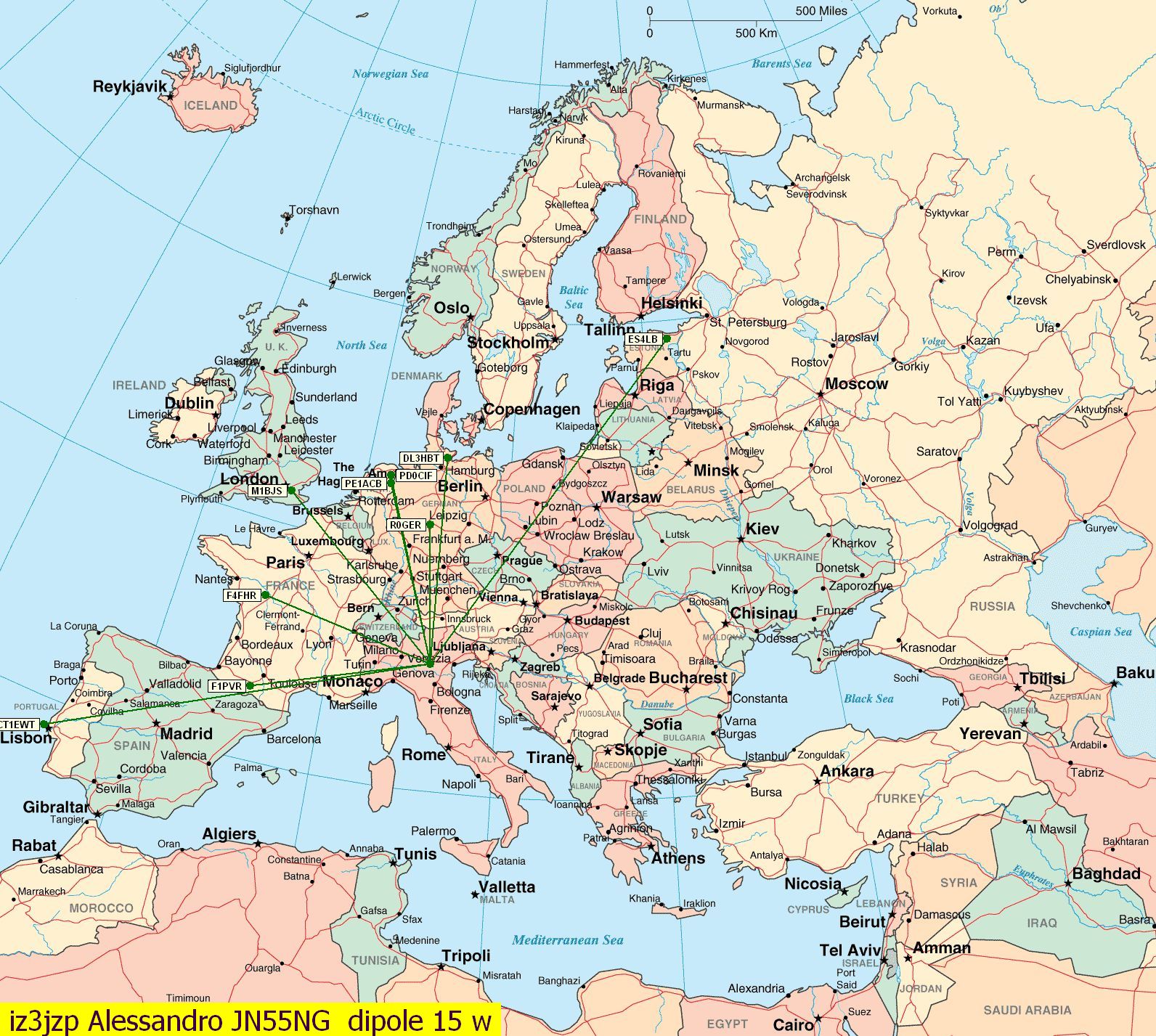 |
|
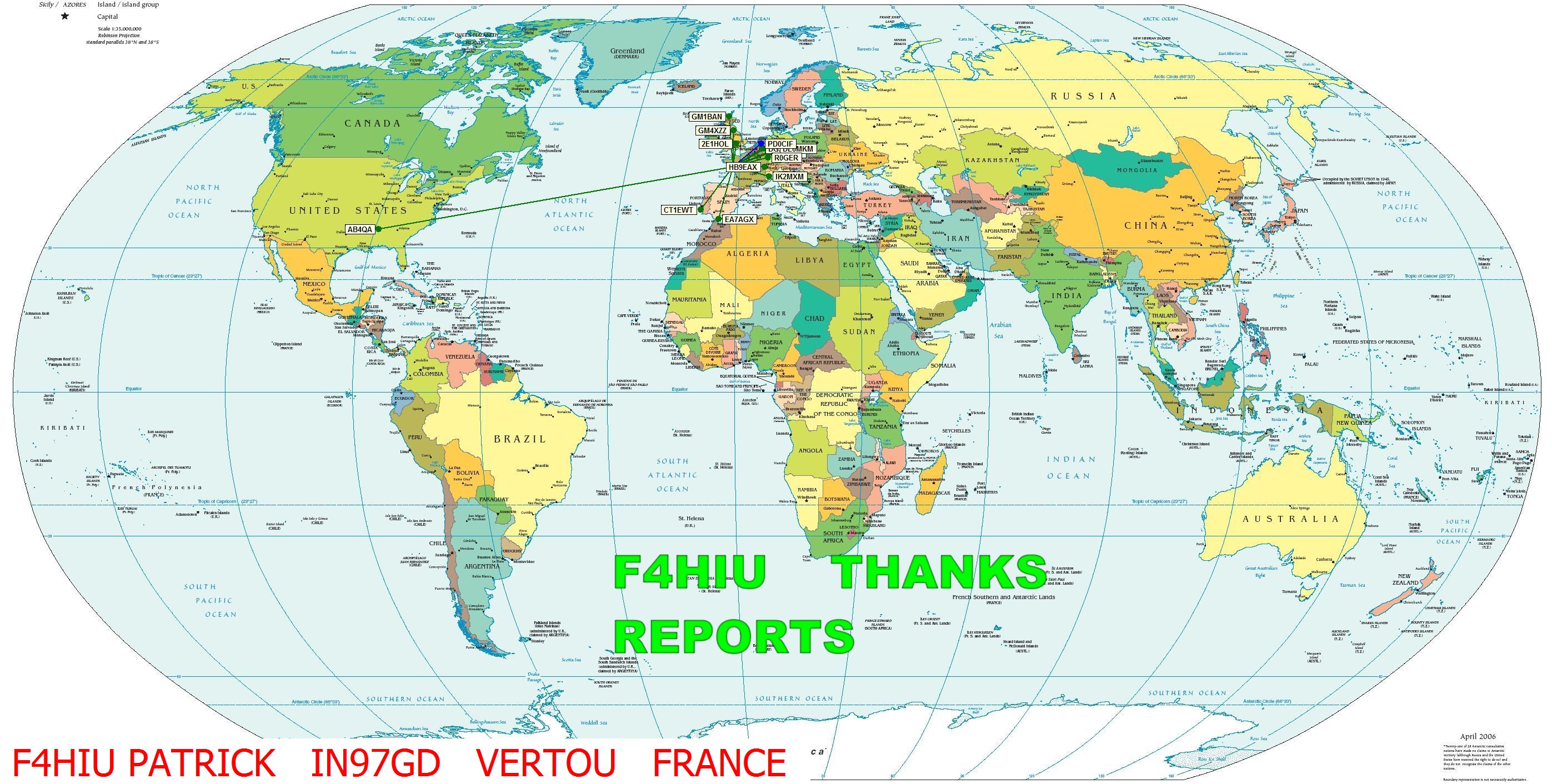 |
|
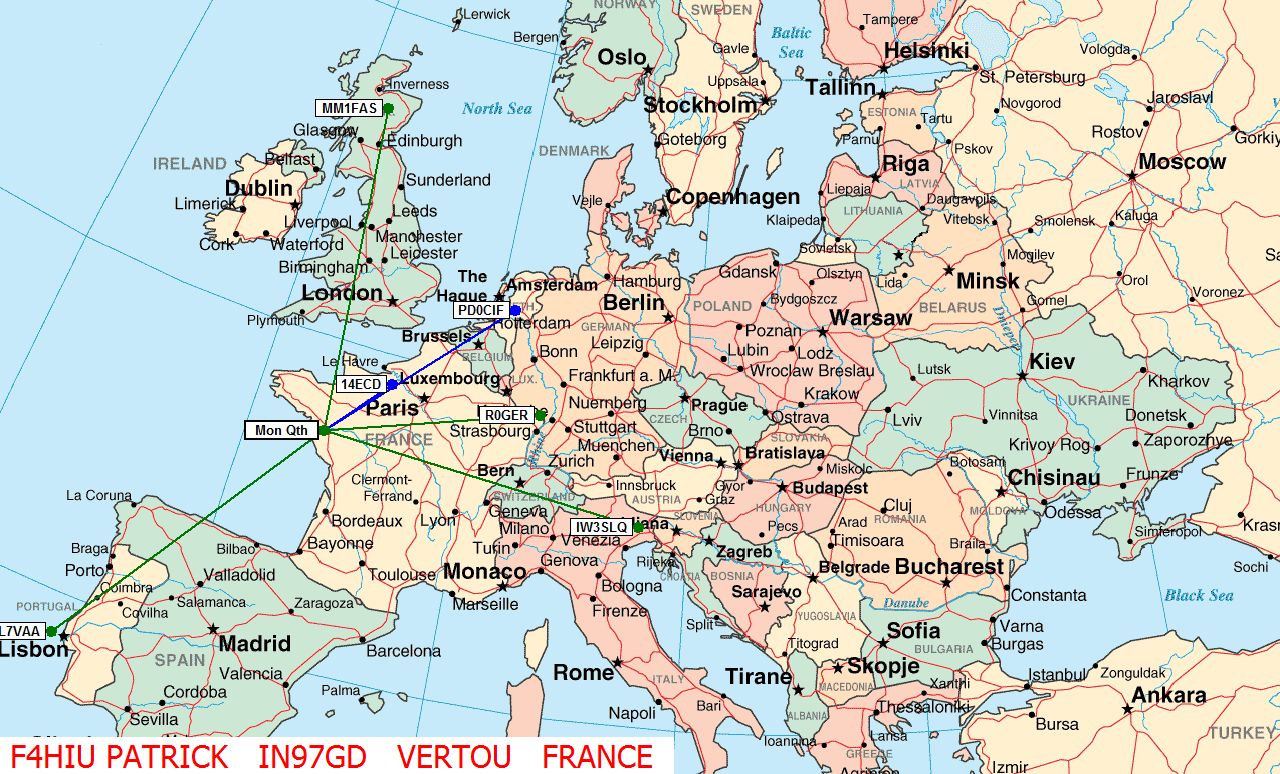 |
|
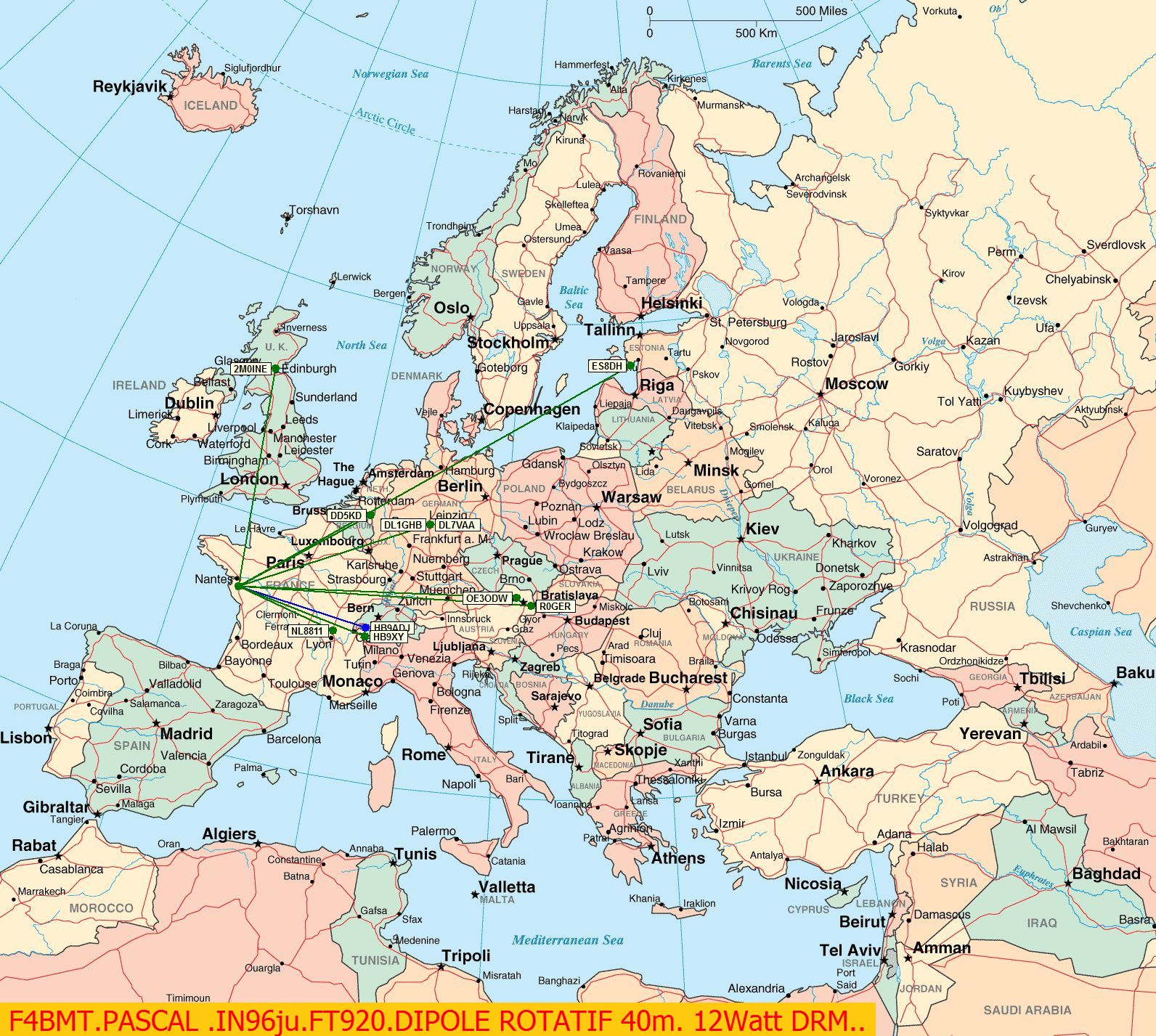 |
|
|
|
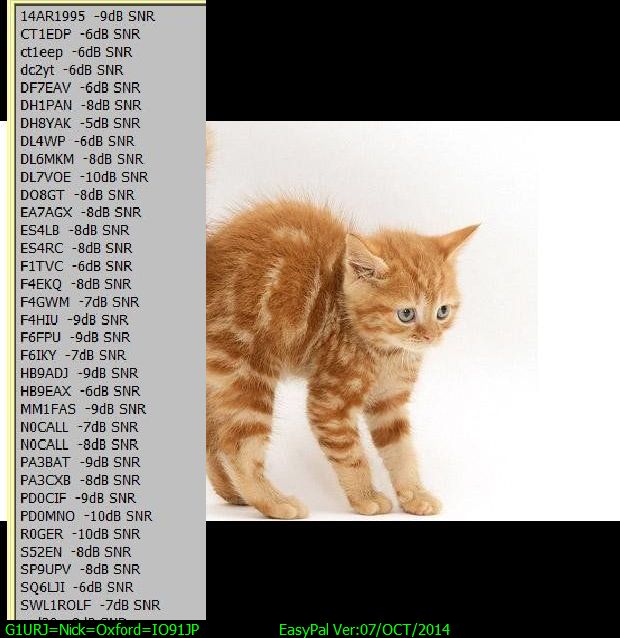 |
|
|
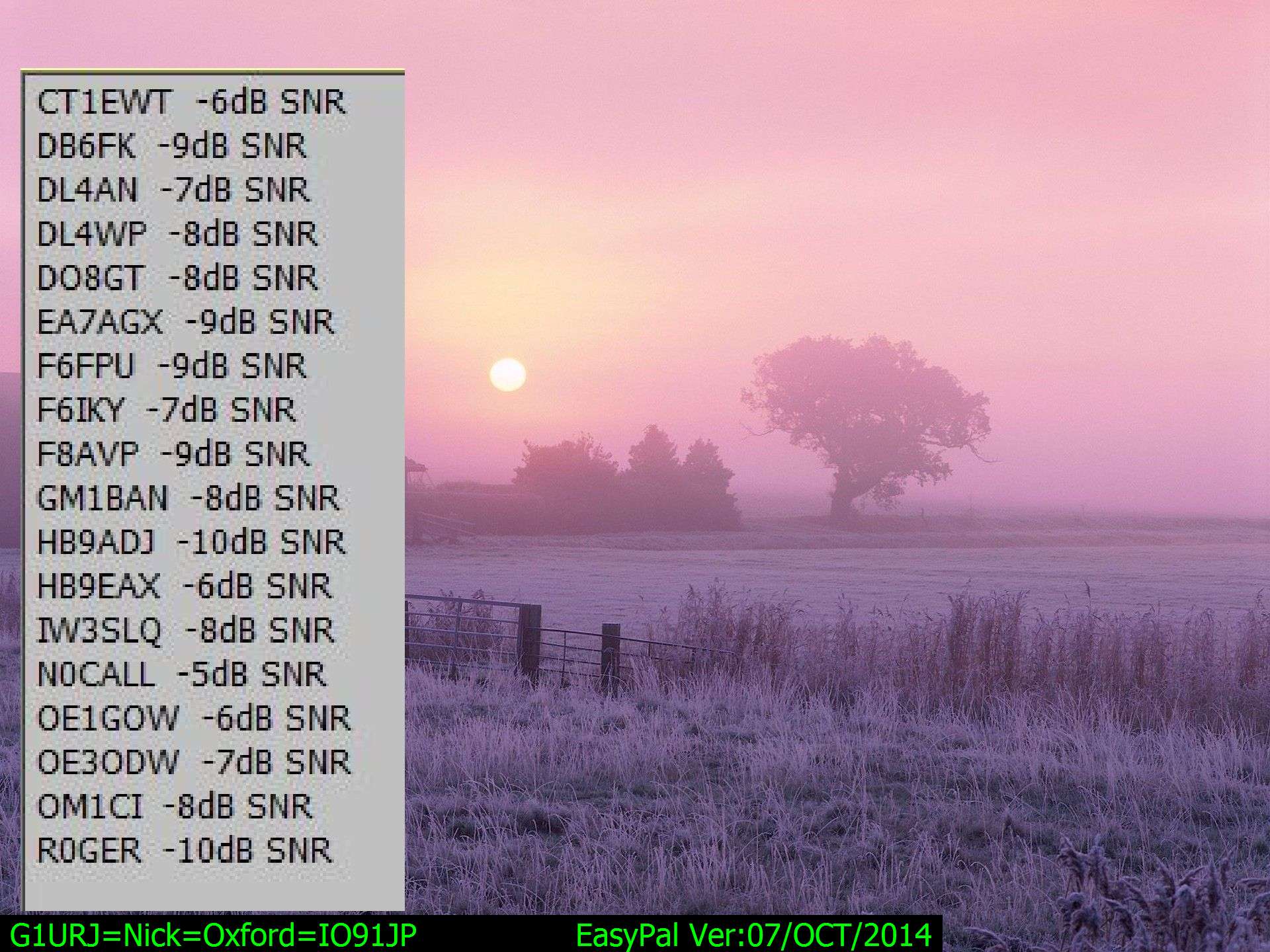 |
|
|
|